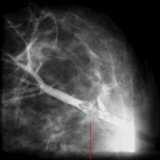Intra-flow papilloma of the mammary gland

Intra-flow papilloma is a benign epithelial tumor of the mammary gland. In women, this trouble is often found before the onset of menopause. Intra-flow papilloma is also called Schimelbusch's disease or Mintz's disease, as well as a bleeding mammary gland. The average age of women with intra-papilloma is 48 years. Women under 20 years of age do not suffer from this pathology, nor does it occur in women older than 50 years.
Causes of
Usually intraprostatic breast papilloma develops due to diffuse or nodular fibrocystic mastopathy, papillomas are formed in the cystically altered ducts, which also expand greatly. There is an opinion that there is a dependence of the development of papillomas on the deviations of the hormonal background.
Clinic
Symptomatic of intraprostatic papilloma: the presence of a painful palpable node, as well as bleeding from the nipple or a greenish-brown discharge. As a rule, these extracts stain the laundry, which causes the woman to feel uncomfortable and uncomfortable.
To reveal this pathology will help the examination, ultrasound of the breast. In addition, you will need doktografiya and cytological examination of discharge from the nipple.
If you perform a thorough palpation of the breast in the area of the areola, you can feel the compaction of the formation of an elastic consistency of round shape. In this case, the node will be located in the central, parotid zone, in the large channels of the subareolar zone. If you press on it, then on the nipple from the mouth a bloody drop is released. The tumor disappears if the ducts are completely emptied of the contents. If, because of the inflammatory process, the walls of the tumor are thickened, then a protective infiltrate forms around the papilloma. In this case, the tumor is painful and dense.
There are cases when multiple bilateral tumors develop in the middle ducts, far away from the nipple. In this case, the only symptom of the disease will be bloody discharge from the nipple, and a thorough examination may not yield any results, as it is sometimes difficult to identify the location of the papilloma.
In the section, the intraprostatic papilloma is a cyst that is filled with papillary inclusions. Inclusions contain a bloody liquid and crumble.
Often, in expanding formations, local circulatory disturbances occur, which causes hemorrhages. As a result, fibro-epithelial cells of the tumor can collapse even before necrosis. Areas of necrosis and hemorrhage in themselves contain a high number of siderophages and macrophages and by this they differ from the consequences that develop in malignant tumors.
Diagnosis
One of the main methods to diagnose intra-flow papilloma, namely the analysis of the analysis of discharge from the nipple. The greatest value in this case is the presence of cells with atypia, since they confirm the diagnosis of intrapropatic papilloma.
Ultrasound and mammography will help to diagnose this pathology. These diagnostic methods make it possible to distinguish intrapropatic papilloma from other types of mammary gland abnormalities.
The most informative way of diagnosing intraprostatic papilloma is the doptography - radiography, during which a contrast agent is injected into the milk ducts.
MRI and mammography, in spite of good diagnostic methods, are not able to show the doctor what condition the milk ducts are in. These methods are able to show a tumor, but to show exactly where the tumor is located they are not able to.
Treatment of
With intraprostatic papillomas, surgical treatment is used. They do not leave, because they can cause cancer. A sectoral resection is performed: in order to expose the ducts that open into the nipple, a cut is made around the areola. After that, the ducts are examined, and if the altered ducts are detected, they are removed, and the surrounding tissues are also removed. All removed tissues are examined in the laboratory for the presence of atypical( malignant) cells.



